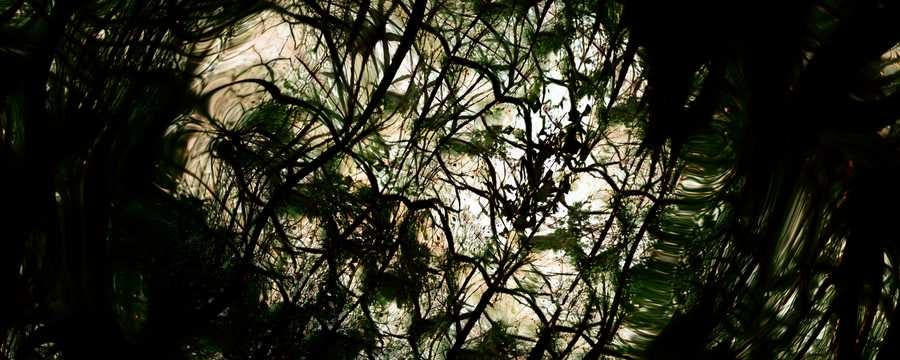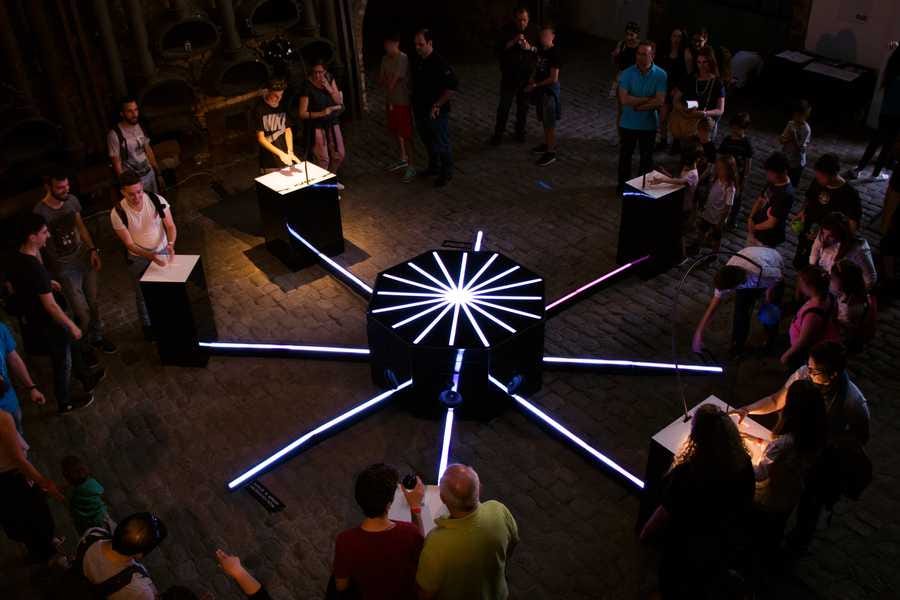Hyperspace, hesitation and non-vision
A friend explained it to me: (Punters per hour X Ticket cost - Overheads) / (Required floorspace). More people, quicker experiences, more $/m²/day. Somehow I’d never thought of it that way before.
As I come to the end of my time in Montreal, I invited those I’d met here to experience SELF ABSORBED on the massive video wall at Concordia University.
My friend Zeph Thibodeau's description of the experience is my favourite of any: “It feels like how I imagine the experience of the Guild Navigators in Dune plotting a path through hyperspace”.
Returning
My sense of time has been contracting these past years. I’d blame the pandemic, but I suspect it began before that. Somehow, it’s two years since I was bunkered away at the beautiful idyll of Cove Park in West Scotland. Here, I first connected the body analysis I'd trained for Sonified Body project to the new image-generating AI, StyleGAN, that I’d just spent 6 weeks training on my lifetime vault of photos. I had a hunch this would be cool but I was instantly hooked on the result. It felt like I was inside the AI’s mind. And that mind was all about me.
Since then, I’ve lugged my heavy PC up and down the UK. I’ve watched as maybe 100 people play with it. The title has changed. The story I tell to explains the work has changed. I’ve added new things: particle-based rendering, depth estimation, generative AI audio for the soundtrack. But all of these I’ve now taken out because I felt they detracted rather than enhanced that core experience.
The only significant difference now is it’s on a massive screen in a dark room. Alongside, many technical tweaks you probably wouldn’t notice but subtly improve the experience: improving the framerate, smoothing out the noisy jitters in the body tracking.
Dead ends are not bad. A lack of dead ends indicates either a failure to take risks or a failure to confront things that aren't working. But it feels odd to arrive two years later back at basically where I started.
The value of hesitation
I was chatting over a coffee with Lynn Hughes, a prof here at Concordia University. I mentioned these explorations with StyleGAN, including Diffeomorphism, my new series of slowly undulating animations.

I’m rendering these from that same AI model with a technique I sketched out in early 2022. Given the pace of this scene, it feels like a mistake to have not put them out a year or two ago if I could have done so.
Lynn spoke of the value of hesitation, of trusting the instinct to pause, of spending time with a work in spite of today's relentless churn of non-stop output. I appreciated that.
During the Pause, the way I see these images has changed. Back then I remember feeling hesitant over the visual aesthetic because I didn’t have a clear grasp on what parts of it were emerging from me (my training data and my selection of outputs) and which were visual tropes inherent to anyone using this StyleGAN model.
It may sound strange that I found myself having created an artwork by myself, and yet unable to distinguish my own contribution from that which lay latent in my tools and materials. But I’m not the kind of person who holds a clear vision of what they are creating. In fact, I have aphantasia and can't even form images in my imagination, much as I'm moved by what I see with my eyes. When working with visual media, be it drawing, photography or coding, I literally have no vision of where I’m going, though I may be able to describe what it will feel like when I get there. The image emerges through the process.
There is freedom in this. And there are traps.
I’ve written before on the tendancy of technology to homogenise human expression by standardising one’s range of actions. Technology that is new, complex and opaque, like AI, makes it extra easy to fool myself into believing that its tricks are my own self-expression. Perhaps, as my creative process is so rooted in exploration rather than navigation, I feel this more acutely.
It’s by seeing what others do with similar tools that I’m able to understand what is me and what is the tool. Two years on, I see myself more clearly in those early StyleGAN explorations. I’m clearer on what I care about. It’s true, many images emerging from the model look like tropes. But others look fresh, beautiful and profound. I’m not sure I saw this distinction so clearly back then. I didn’t realise where to dig, and how deep to go.
The dance between intuition and vision
In a work like SELF ABSORBED, the process and concepts were clear from the outset. They are embodied in the technologies and algorithms I develop. But the outcome: what it looks like, sounds like, feels like, whether it’s an interactive installation or a video – over these, I want to release preconceptions. For these, I find myself talking about trying to uncover what the work wants rather than what I want.
This type of creation, where material is encountered rather than invented, is familiar from musical improvisation, and from observing dancers in the studio. It’s often the kind of experience I’m aiming for in an interactive work. The gestural hyperspace navigation of SELF ABSORBED is an extreme example. It gives you detailed, intuitive and consistent control. Yet it defies any logic that might let you predict beyond what you’ve already encountered. It is pure exploration. I love it for that.
But more often, there is a dance between explorer and navigator. While moving intuitively through possibilities, I encounter a glimpse of something and navigate towards it.
Last year I was coding a simulation of particles that repel each other yet are drawn to a common attractor – similar to how flies swarm. I rendered the trail each left as it moved. In it, I saw something reminiscent of a flower growing, and I iteratively tweaked the code to bring out that image. This became my series a Heaven in a Wildflower.
and you are the easiest person to fool
“The first principle is not to fool yourself – and you are the easiest person to fool.” – Richard Feinmann
Over these two years, I’ve pitched variations of this work to many festivals. Only the weird world of Electromagnetic Field festival were keen. (And it was great – one of the most exciting festivals I’ve been to.)
So all these ponderings may be rationalisations for the disappointing lack of traction I’ve had in finding opportunities to show this work.
I can only speculate why. Maybe I don’t have as much energy to hustle work into places as I used to. The world is already saturated with AI art and art about AI. Festivals are not keen on interactive works created for one person to use at once. Even Cave of Sounds got rejected from a festival once on the sole grounds that they can’t squeeze enough punters through it. And that looks like this:

A friend explained it to me recently:
More people, quicker experiences, more $/m²/day. It’s obvious when someone writes it out, but I’d actually never thought of it that way before.
Maybe I just arrived into this tech-art space at the right time 11 years ago. Today it feels like a giant burn out to me. I rode a great wave, but now I’m at paddling at the shore, the sea is full of desparate people, and there’s barely any surf anyway. My instincts have been telling me a while but the deeper you are in something the harder it is to confront when it’s time for something different. The problem with being an explorer is you keep thinking there’s probably a break just round the corner, even when actually they’re all really far away. It’s time to catapult out of this deteriorating local optimum and meander through the hyperspace of future possibility. How many metaphors can I mix to say one thing. :)
Tim
Montreal, 16 June 2023

